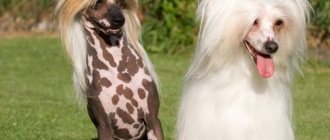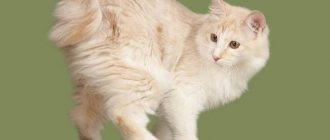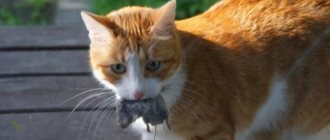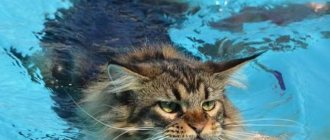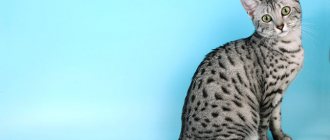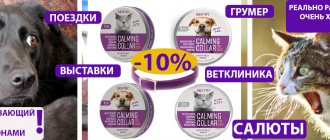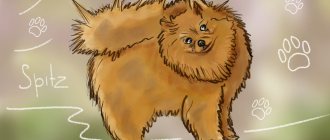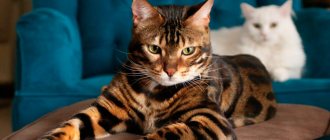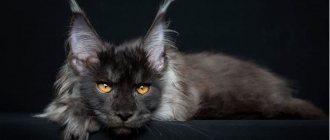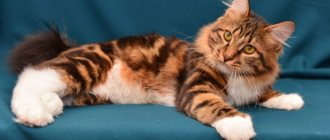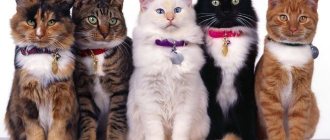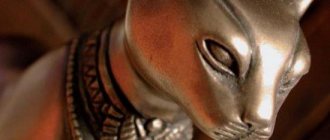Sincere love for pets often forces you to put up with scraps of fur that settle on clothes and furniture during molting. But there are cat breeds that do not shed and are very easy to keep at home.
Read the article to the end, there you will find useful information about animal shedding and allergies (not only to wool).
Sphinxes
Watch a video about cat breeds that do not shed on our Youtube channel Mr. Cat:
List of cat breeds that do not shed or smell
Felinologists have long been engaged in breeding work in order to create a breed that has virtually no odor of its own and is not prone to shedding. While the result is not one hundred percent, it is possible to identify some breeds that at least partially meet these requirements.
Hairless cats
Hairless cats include Sphynxes - Canadian, Donskoy, St. Petersburg, as well as selective breeds bred by crossing with them - Bambino, Elf, Dwelf, Ukrainian Levkoy.
Sphinx cat
The advantages of these cats are obvious. They have practically no fur, only individual hairs that completely or partially cover the body and have a length of no more than two millimeters.
But this does not mean that they do not need to be looked after. More often than not, this causes additional difficulties.
Brown sweat appears on hot bare skin, which must be removed daily by wiping your pet with wet wipes. And once a week, a bathing procedure is required.
In addition, it is necessary to carefully monitor the diet of these animals. At the slightest dietary disturbance, sweating increases and acne may appear on the skin.
The lack of fur makes it necessary to purchase special clothing for hairless cats, since they are very heat-loving and easily catch colds. Sphynxes have a weak, specific odor that some people do not notice at all, while others react negatively to it.
By nature, all sphinxes are calm and cheerful pets, deeply attached to their owners.
Cat Bambino
Rex
This group of cats is distinguished by short and wavy hair that lies close to the body, has no undercoat and practically does not shed.
Rexes known today:
- Cornish;
- Devonian;
- Ural;
- Hermann;
- Selkirk;
- Laperm.
Rexes have almost no smell, they have a wonderful character, are active and playful, and love children very much.
These pets are clean and do not need constant washing and combing. But their diet also needs to be carefully monitored. If the diet is not correct, dark discharge may appear on the back and sides.
Siamese-oriental group
It contains breeds that do not have undercoat. All these animals come from the east and warm countries. Historically, their ancestors lived in hot countries and with the change of season there was no need to “change their outfit.”
The fur of these animals is short, shiny, and lies tightly to the body. If you run your cat’s body at least once every day with wet hands, then a natural change of guard hair will occur unnoticed.
This group includes:
- Siamese;
- Abyssinian;
- Orientals;
- Thai cat;
- Mekong Bobtail;
- Skif Tai Don;
- Balinese;
- Burma.
All of these animals, with the exception of the Siamese cat, have a wonderful character. They are cheerful, very active, inquisitive and devoted to their owner.
The Siamese also does not suffer from passivity, but due to anatomical features (defects of the tail and, consequently, the spine itself), it can be irritable and vindictive.
If your pet's fur suddenly begins to shed intensively, this may be the cause of stress, a hormonal storm, or an incipient disease. It is necessary to consult a veterinarian and follow his recommendations.
Russian blue
This wonderful ancient domestic breed of natural origin, although it has a dense undercoat, is distinguished by the fact that it is little subject to shedding, is very beautiful in appearance due to its unusual color and has practically no odor. The pet has a wonderful character, he is unconditionally devoted to his owner, loves children and treats them like a father. It is not for nothing that this breed is among the ten most sought after in the world.
In addition, this cat is very clean; she constantly takes care of her wonderful fur coat.
Cat fur is considered hypoallergenic. The structure of the hair is such that it is little susceptible to destruction, so bacteria do not settle on it. Reduced hair fragility leads to the fact that the Russian Blue sheds imperceptibly throughout the year, with virtually no undercoat loss.
This cat should not be combed, washed or used with chemical grooming products, so as not to damage the unique hair structure.
Read more about the Russian Blue.
Nibelung
This is a rare breed, which is practically never found in Russia; in all its parameters it is very similar to the Russian Blue. The only difference is that her hair is not short, but semi-long.
The structure of the hair under a microscope allows you to see that it is no different from blue. Therefore, there is no seasonal shedding and the cat is hypoallergenic.
More about the Nibelungs.
Bengal
This amazing breed is the world's first successful hybrid of domestic and wild cats. The ancestor of the Bengal is the Asian leopard cat.
This breed is distinguished by the fact that it requires absolutely no grooming. There is absolutely no need to comb or wash your pet.
A week after birth, kittens begin phasing. This is a process common to all wild cats. It lies in the fact that the baby’s bright color is hidden behind a thick undercoat, which suddenly grows and becomes longer than the guard hair.
In nature, the kitten becomes almost invisible and blends in with its environment. In a Bengal, this manifests itself in the fact that the baby loses its brightness and attractiveness.
The pet grows, is separated from its mother, begins to eat solid food, and learns about the world. His muscles fill with strength, and his body becomes swift and light.
And at one point all the undercoat comes out. By 4-9 months, the ugly duckling turns into a glittery, shiny, like a kid glove, handsome. The Bengal never grows any more undercoat in its life, which means there are no seasonal or indoor shedding.
Phasing was “invented” by nature to protect brightly colored babies from predatory enemies. While the baby is weak and cannot stand up for himself, he should be invisible; the mother is responsible for his life and health.
Also read the great article about Bengals.
When a growing cat gains strength, its color appears in all its glory, and it is ready for independent life. Therefore, Bengal is also a hypoallergenic breed that is not subject to shedding and has virtually no odor.
By nature, they are energetic and cheerful animals, sincerely attached to the owner and household members. They do not tolerate loneliness well, so it is better to buy them in pairs from the nursery.
Features of non-shedding breeds
The shedding process is considered a physiological norm for most breeds of domestic cats.
Therefore, they all lose their fur to one degree or another. Of course, those with short fur coats shed less fluff than their shaggy counterparts with a voluminous undercoat. All low-shedding breeds have a number of features:
- absence of down or guard hair;
- presence of coarse or curly hair.
Thanks to this, such cats hardly shed, and are also less likely to cause allergies.
A little about molting
All cats with fur experience natural hair loss. This process occurs much more intensely in long-haired breeds and in animals with voluminous undercoat.
Since the fluff in the lower layer has a finer structure, changing this hair brings more inconvenience to the owners - weightless pieces of fur fly throughout the house, settling on clothes and furniture, getting into the eyes and getting into the respiratory tract.
It is not so difficult to survive seasonal shedding; it occurs twice a year - at the beginning of spring and autumn, when the undercoat changes.
But domestic cats that do not walk outside often experience the effect of “indoor” shedding. The cat is constantly warm and shedding its undercoat occurs almost constantly.
Also read what to do if your cat is constantly shedding.
Tips for owners of shedding animals
If your choice fell on an animal with normal or heavy shedding, the situation can still be alleviated.
Reducing shedding
There are several ways to reduce natural hair loss.
Nutritious food
Analyze the animal's diet. It should have a lot of protein. A month before shedding, give your pet B vitamins and fatty acids. The medications and the regimen for taking them must be prescribed by a veterinarian.
It is useful to keep cat grass or sprouted oats at home - cats usually eat them with pleasure, replenishing the supply of nutrients in the body.
Cats instinctively love to eat grass that is good for them.
For long-haired breeds, it is recommended to use a paste that makes it easier to remove hair from the stomach.
Abyssinian
The Abyssinian fur coat is dense and very short, and does not require special care. The molting of an animal does not cause any trouble to the owner.
The maximum that can be found on a cat's bedding is a single tiny fiber. The Abyssinian cat is quite clean, quickly gets used to the litter box, and the presence of unpleasant odors is not typical for her.
Thai
The standard for this breed was registered relatively recently, in 1990. In appearance, Thai cats resemble rounded Siamese cats with shorter legs.
Thais are unpretentious and affectionate. Their shedding is rare and does not create problems because there is no undercoat. Animals do not have fatty or sweat glands, which eliminates their unpleasant odor.
Werecat or Lykoi
If we really delve into the exotic, then those who like scarier things will definitely appreciate Likoi. This incredible breed in appearance really resembles a half-wolf, half-cat. The pet of this breed is not completely bald. Its coat simply has an uneven distribution, which gives it a somewhat frightening and folkloric appearance.
The fur of an adult may be completely absent or partially present on the body. The back is usually colored a smoky black, and the coat is ragged in texture. The body is quite flexible and at the same time strong. The head is wedge-shaped. This breed of hairless cats, if it can be classified as such, appeared due to a mutation. The latter manifested itself in the development of hair follicles.
Expert opinion
Danilova Maria Alekseevna
Therapist, dentist, ophthalmologist, surgeon, express tests, ratologist, groomer.
If compared with the same Dwelf and Elf, then the Likoi received official status as a separate type of cat. This happened in 2012.
Find the perfect cat for you
It is no secret that the appearance of hairless cat breeds is very exotic and does not correspond to the aesthetic preferences of all potential cat owners. Such cats are, as they say, an acquired taste. If you are a connoisseur of exotic things and are extremely intolerant of wool in your home, the Sphynx will suit you better than anyone else. If in your mind the cat is a wool cat, but a non-shedding member of the family, you should pay attention to representatives of low and moderate shedding breeds. There really is plenty to choose from here, including Rex and Siamese-Oriental cats, Bengal and Russian Blue - the appearance of such cats is the “golden mean” between long-haired beauties and their hairless relatives. Their short hair in most cases covers the entire body, and its amount during shedding is close to zero.
Having decided, however, to purchase a kitten of a hairless or short-haired breed, you need to find out other nuances of caring for a potential pet. Often, proper care for representatives of these breeds has its own difficulties, because it requires much more time and effort compared to periodically combing a pet’s fur and cleaning the apartment during seasonal molting.
Cornishrex
© shutterstock Cornish Rex cats are quite unique looking cats, as they have sparse fur and no guard hairs, which make up the top layer of fur that often protects cats from water. As you might have guessed, no guard hair means he loses less fur! These cats are very sociable and love human interaction. They are also slow to mature and will exhibit kitten-like behavior as adults.
Sphinxes
There are many varieties of this breed, but they all have completely or partially reduced hair, and often even lack mustaches and eyebrows.
According to the condition of their hair, cats of this breed are grouped into the following categories:
For those cats that have a sparse coat, it may shed and not regenerate as they age.
The most captivating feature of the Sphynx is its extreme friendliness and affection for its owner. They love tactile contact, so they happily sit in their arms or sleep next to their owner.
Among the sphinxes, you should pay attention to the following representatives of the group:
- Donskoy.
Sometimes kittens appear woolly, but even then, by the age of two they become completely hairless, so they no longer shed.
- Canadian.
These cats have folded skin, especially in the forehead area, and this makes them different from other cats. Mustaches and eyebrows are almost always absent. Large ears and wide eyes make their faces very cute.
Bambino
Bambino is often jokingly called the dachshund's love child. This is explained by the fact that this cat has a long body and short legs. Nevertheless, such a non-standard structure does not prevent them from being extremely curious and playful. The name of the breed translates as “child”. Considering the external childishness of the animal, which it retains into adulthood, the name of the breed fully justifies itself.
The skin is soft and covered with tiny folds. Short legs and hairless type were obtained through effective crossing of Don Sphynxes and Munchkins. The latter's paws are almost three times shorter than those of ordinary cats.
Choosing a non-shedding breed together
A little advice: start stroking your cat with wet hands or special “cat” gloves - this way you will collect a lot of hair. And, in addition, protect your furniture and belongings.
So, a perfectionist's dream: “hairless” cat breeds. It is quite clear why - there is simply no fur on them, and there is no strong smell. Of course, specific cat secretions are released, but this can easily be removed with wet wipes. Consider these breeds:
- bambino;
- Dwelf;
- elf;
- sphinxes: St. Petersburg, Don, Canadian;
- Ukrainian Levkoy;
- Devonian;
- Cornish
Siamese-oriental group
The most profitable options from the Siamese-Oriental group for a person who does not want to deal with the fact that his pet has begun to shed intensively are the following breeds:
If cats belonging to these groups begin to shed heavily, then an urgent need to look for the cause, since such a phenomenon cannot be called normal. The most common factors are:
In this case, it is best to show your pet to a doctor who can dispel doubts and, if necessary, recommend a normal treatment regimen and measures. After their use, the animal should stop pathologically shedding.
Balinese
The Balinese breed comes from the Siamese, there are practically no differences between them except for the length of the coat. The Balinese are distinguished by a chic fluffy tail, which they carefully care for.
However, due to the lack of undercoat, these cats do not form tangles, and shedding is almost unnoticeable.
In the process of caring for an animal, it will be quite enough to comb it with a brush 2 times a week. In addition, Balinese have no odor at all, which makes them ideal for keeping at home.
Recommend: Cat Parasites
Bengal
These cats have an external resemblance to a leopard due to their spectacular spotted color. But unlike their wild relatives, they pose no danger.
Bengals are very friendly and do not cause any problems in keeping them. They have no odor at all, and caring for their short hair does not require time or effort.
You won't find pet hair all over the house, only single hairs that practically do not cause an allergic reaction.
